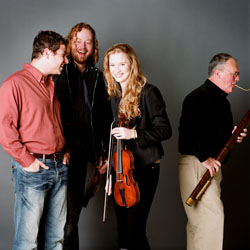The collaboration between SFEMS and the California Jazz Conservatory continues on Sunday, March 8, with a program celebrating the early Venetian baroque as well as International Women’s Day. Passamezzo Moderno (Jonathan Davis, harpsichord and organ; Edwin Huizinga and Adriane Post, violin; and David Granger, dulcian) with guest artists Ondine Young and Alicia Yang, violins; and Bruce Chrisp, sackbut, explore the music of three masters from the first generation Venetian baroque composers (Dario Castello, Biagio Marini, and Giuseppe Scarani) as well as works of two other great 17th-c. composers, Isabella Leonarda and Élisabeth-Claude Jacquet de La Guerre.
 Early 17th-century music is perfect for showing improvisation in the baroque, and the musical innovations of 1629 Venice were a giant leap forward in baroque instrumental music. Three publications from Venice by three different composers influenced the future of music in Europe and make that year a turning point year in the evolution of the baroque. Biagio Marini’s Sonate, sinfonie, canzoni…, opus 8, published in Venice, but while he was in Nuremburg, is Marini’s largest collection of instrumental music. In Opus 8, Marini explored unusual compositional techniques, for example triple stopping, an idea that would not be embraced by other composers for decades. Copies of Dario Castello’s Sonate concertate in stil moderno, dedicated to Emperor Ferdinand II, can be found in collections throughout Europe. Castello was a pioneer of musical notation, being one of the first to include clear tempo markings, bar lines throughout, and indications to use the harpsichord instead of the organ as a continuo instrument. In 1629 Giuseppe Scarani, a Carmelite monk and organist from Mantua, was employed as a singer at the Basilica of St. Mark’s. A year later he published a collection of sonatas under the title, Sonate concertate, that his colleague, Castello, had used in his, now popular, collection. Castello’s and Marini’s collections are early baroque masterpieces, and their influence is easily seen in Scarani’s collection. These composers through their work expanded the musical language of the Baroque through their innovations, changing the course of Baroque music throughout 17th-century Europe.
Early 17th-century music is perfect for showing improvisation in the baroque, and the musical innovations of 1629 Venice were a giant leap forward in baroque instrumental music. Three publications from Venice by three different composers influenced the future of music in Europe and make that year a turning point year in the evolution of the baroque. Biagio Marini’s Sonate, sinfonie, canzoni…, opus 8, published in Venice, but while he was in Nuremburg, is Marini’s largest collection of instrumental music. In Opus 8, Marini explored unusual compositional techniques, for example triple stopping, an idea that would not be embraced by other composers for decades. Copies of Dario Castello’s Sonate concertate in stil moderno, dedicated to Emperor Ferdinand II, can be found in collections throughout Europe. Castello was a pioneer of musical notation, being one of the first to include clear tempo markings, bar lines throughout, and indications to use the harpsichord instead of the organ as a continuo instrument. In 1629 Giuseppe Scarani, a Carmelite monk and organist from Mantua, was employed as a singer at the Basilica of St. Mark’s. A year later he published a collection of sonatas under the title, Sonate concertate, that his colleague, Castello, had used in his, now popular, collection. Castello’s and Marini’s collections are early baroque masterpieces, and their influence is easily seen in Scarani’s collection. These composers through their work expanded the musical language of the Baroque through their innovations, changing the course of Baroque music throughout 17th-century Europe.
Improvisation in the Early Baroque
The “prelude” before the baroque era was an improvisation that preceded a work in order to introduce the listener to another piece whose mode, or key, may have been different from the preceding work. The word prelude has many roots: from France (préluder) and Germany (präludieren), both meaning to improvise, and the Latin praeambulu, from rhetoric, the task of attracting an audience and introducing a topic. The prelude, both improvisational and written, was for a solo instrument, most often keyboard, and the practice of improvising between pieces, common during the Renaissance, continued into the early baroque. During the baroque, the title of prelude began to be used for any number of musical forms that indicated an improvisatory style and as an introductory movement for a longer work.
Passamezzo Moderno’s concert begins at 4:30 p.m., at the California Jazz Conservatory (formerly The Jazzschool), 2087 Addison St., between Shattuck and Milvia, in downtown Berkeley. The venue is one block from the downtown Berkeley BART station, and parking is easily available at the Addison Street parking garage. Street parking is free on Sundays and also relatively easy in the afternoon. The school’s café is open prior to and during the concert, allowing audience members to enjoy a glass of wine, coffee, or a light snack.
All tickets are $15; reservations are highly recommended, as the venue is small and intimate. For reservations and information, please call the California Jazz Conservatory at 510-845-5373 or email info@cjc.edu.












